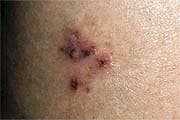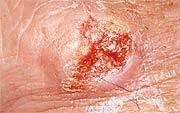Life Extension Magazine®
Few people are aware that about half of all cancers occur in the skin… far more than any other part of our body.1 While most skin cancers are curable,1 they can be disfiguring and expensive to treat. Doctors claim that sun exposure is the leading cause.1 Yet even in geographic areas where solar ray exposure is limited, rates of certain skin cancers have more than doubled in less than a decade.2 Like virtually all cancers, aging is the primary culprit.3,4 That’s because aged cells suffer an accumulation of mutations to genes that regulate their proliferation.5 Aging people are much more vulnerable to contracting skin cancers from even limited exposure to solar radiation.6 The public has been alerted to the grave dangers of melanoma, but remain largely in the dark about another deadly cancer (squamous cell carcinoma) that strikes almost four times as many Americans.7,8 Like melanoma, the incidence of squamous cell carcinoma is related to aging and sun exposure.4 Applying a topical sun-blocking agent daily makes common sense, not only to guard against skin cancer, but to also protect against premature skin aging.9,10 The unfortunate reality is that few people take the time to adequately shield their skin against damaging solar rays every day. As you will read, an orally ingested plant extract has been discovered to confer remarkable protection against sunburn and solar ray skin cell damage. Supported by extensive research, this new oral supplement offers convenient protection against ultraviolet light damage to the largest organ of the body… our skin! Nearly half of all adults who reach age 65 will suffer from some type of skin cancer.11 This depressing statistic may soon become a historical curiosity owing to a Central American fern plant whose sun-protection benefits are proving to be nothing short of miraculous. It is called Polypodium leucotomos and has been used for centuries to treat tumors, skin diseases (including psoriasis), and sunburn. Modern dermatological researchers have discovered that the oral ingestion of this fern may provide previously unavailable skin cancer protection by blocking dangerous ultraviolet (UV) rays in living skin. In study after study, this Polypodium fern is proving to decrease the consequences of acute sun exposure, such as redness and sunburn-cell formation. It also helps maintain specialized immune cells in the skin that fight cancer,12 while inhibiting collagen-destroying enzymes that contribute to skin aging.13 Additional research shows that this special fern decreases the infiltration of damaging inflammatory cells in skin12,14 and increases survival of healthy skin cells.15
Early Research Into the Polypodium FernThe medicinal properties of Polypodium fern plants have been part of the traditional culture of Native American tribes across Central and South America for centuries. Dr. Salvador González is a physician-researcher in dermatology and photo-medicine with ties to some of the world’s most prestigious medical research institutions. Dr. González’s interest in this species of fern plant began during his doctoral work at the University of Malaga, Spain, when he was studying treatments for psoriasis (a disorder characterized by inflammatory scaly red patches of skin).
One such psoriasis therapy involves applying a light-sensitizing agent to the skin area followed by irradiation with ultraviolet A light. This treatment targets psoriasis by inflicting damage to the affected area. Unfortunately, this ultraviolet radiation therapy is associated with considerable inflammation in healthy tissues that can lead to increased rates of skin cancers over time.16 Polypodium leucotomos had been previously approved by the Health Ministry of Spain17-19 for psoriasis and atopic dermatitis. When Dr. González gave Polypodium leucotomos extracts to patients undergoing radiation therapy for psoriasis, he noticed that without exception, the skin of these irradiated patients was in much better shape compared with untreated irradiated groups. In the patient group receiving this natural fern extract, there was no evidence of phototoxicity, redness, or burn. In fact, the skin of the fern-supplemented patients was comparable to those who never underwent high-intensity ultraviolet light therapy. These results sparked Dr. González’s interest in photoprotection, and he extended his work during a stay at Harvard Medical School, where he and his colleagues discovered more about the impressive properties of this Native American fern plant.20 Protecting against clinically induced radiation therapy is interesting, but in the real world, most skin damage comes from sunrays. In his search to develop a more advanced form of sun protection, Dr. González began to study the effect of Polypodium leucotomos on protecting the skin against the DNA damage we all experience through daily sun exposure.
Multiple Protective Effects Against Solar RadiationOne of the first clinical studies sought to find out if Polypodium leucotomos extract, applied topically or ingested orally, could protect against solar radiation damage.21 An initial study was conducted on 21 volunteers, 13 of whom were pre-treated with a light-sensitizing agent. All the volunteers were exposed to solar radiation.21 The researchers recorded the following clinical effects of sunlight on the subjects’ skin:
The study subjects then took either an oral extract of Polypodium leucotomos or applied it topically and underwent another period of sun exposure. After repeating the same clinical measurements of sun damage, the researchers found that both topical and oral treatments were effective in protecting against the sun’s rays. Particularly impressive were findings that following treatment, the amount of sunlight that subjects could tolerate before experiencing any reddening of the skin was increased nearly three-fold.21
In fact, some subjects in the group given the light-sensitizing agent experienced nearly a seven-fold increase in the amount of light their skin could tolerate before cell damage occurred. Microscopic studies of the skin showed that vital cancer-fighting immune cells—called Langerhans’ cells—were preserved by the fern treatment as well.21 Dr González’s research had created an oral form of sun protection—something that was previously thought to have been impossible. Controlled Study Verifies Initial FindingsTo further assess the effectiveness of this special fern, researchers conducted a study where one group received the oral Polypodium leucotomos extracts, while the other group received no treatment.12 Study subjects were healthy, but had fair to light skin, making them more vulnerable to sun damage. The active group was administered the fern extract (7.5 mg/kg body weight), a dose that translates to 525 mg for a typical 154-pound person. Both groups were then directly exposed to varying doses of artificial ultraviolet radiation. At 24 hours after radiation exposure, the skin-reddening reaction was assessed. The scientists also took skin biopsies for comparison of treated and untreated skin. The results showed that treated subjects who ingested the Polypodium fern extract experienced a significant decrease in skin reddening. Microscopically, the biopsies taken from the treated subjects showed a significant decrease in the “sunburn cells” that indicate ultraviolet light-induced tissue injury, as well as a reduction in the kind of molecular damage to DNA that initiates cancer. There was also a reduction in the infiltration of cells that lead to age-related changes in the skin. Additionally, as with the other study, the vital Langerhans’ cancer-patrolling immune cells were protected.12 Based on all these impressive results, the researchers concluded, “Oral administration of Polypodium leucotomos is an effective systemic chemophotoprotective agent leading to significant protection of skin against UV radiation.” Oral Fern Extracts Protect Against Medical RadiationThe same research group next explored whether these special fern extracts might benefit very light-skinned patients undergoing medically induced radiation therapy to the skin.22 This is an important concern, because this treatment in fair-skinned people is often of limited use due to painful side effects and possible long-term increase in cancer risk.16
In this study, 10 fair-skinned people were first exposed to a light-sensitizing agent followed by high-intensity ultraviolet light therapy. The researchers measured the effects of this medical radiation therapy alone and also when the oral Polypodium leuco-tomos extracts were ingested. Skin damage observed 48 to 72 hours after this radiation therapy was lower in patients who ingested Polypodium extracts. There was also significantly less skin damage four months later. As with the previous studies, there was a significant reduction in sunburn cells and a marked preservation of the Langerhans’ cells.22 Protecting Against “Sun-Poisoning”In addition to sunburn, some people suffer from skin lesions (idiopathic photodermatoses) that are often referred to as “sun poisoning.” In 2007, a group of Italian researchers studied oral fern extracts as photoprotectants in a group of 25 sufferers of these conditions.23 The researchers first ensured that their subjects had not used any ultraviolet light-protecting sunscreens. The subjects were then exposed to sunlight during daily oral supplementation with 480 mg of Polypodium leucotomos fern extracts. The patients’ responses were compared with those they had previously experienced during ultraviolet light exposure without supplementation. The findings showed a dramatic reduction in immune-associated skin reactions and symptoms (itching and discomfort) after taking the fern extracts. All patients, as in the other studies, tolerated the Polypodium leucotomos fern extracts without side effects of any kind. How Polypodium Fern Extracts WorkScientists have shown that Polypodium leucotomos is a very good antioxidant that works at least partially by quenching free radicals.20,24,25 But there are plenty of potent antioxidants that have not been shown to protect the skin against radiation damage.
What is unique about this Polypodium fern is that after oral ingestion, it seems to have strong affinity for the skin compared with most standard antioxidants, a characteristic that gives it a highly selective targeted action. Polypodium leucotomos extracts also seem to act as an ultraviolet-absorbing material that filter out or block ultraviolet radiation. In addition, these extracts have been shown to inhibit protein-destroying skin enzymes that decrease skin elasticity.13 With further study, this property may yet prove to help delay the visible skin aging effect of solar radiation exposure. These mechanisms help explain why in study after study, Polypodium leucotomos extracts are proving to decrease the consequences of acute sun exposure such as redness, sunburn-cell formation, and suppression of cancer-fighting Langerhans’ cells.12 Protecting Against Skin CancerIntriguing research provides a rationale on how Polypodium leucotomos extracts may protect against cancer. These fern extracts reduce DNA damage in skin cells produced by the dangerous short-wavelength UVB radiation that is associated with skin cancer.12,26 Dr. González notes, “Polypodium leucotomos probably helps reduce DNA damage indirectly by protecting the special enzymes that repair DNA from oxidative damage of their own.” The significance of this finding is that this effect may allow for better DNA repair and subsequently fewer mutations that can initiate cancer. In fact, Dr. González recently showed that “Polypodium leucotomos inhibits the UV radiation-induced conversion of one of the skin’s most powerful antioxidant molecules into a specific immune-suppressing molecule.”27 Suppressing this vital first line of defense is just one of the many links in the chain in which sunlight damage can lead to skin-cancer development. Protecting Against Other Sources of RadiationWhat of Polypodium leucotomos’s potential in protecting against other forms of ionizing radiation, such as that used in radiation treatments for cancer? Regrettably, such studies have not been performed yet. We do know that radiation therapy causes an enormous increase in the levels of free radicals in the skin of the exposed area, and the use of Polypodium leucotomos is likely to quench these reactive oxygen species, thereby alleviating the harsh side effects of such aggressive therapies. It is also worth noting that Polypodium leucotomos has a boosting effect on the immune system,22 probably related to its protective effect on radiation-sensitive Langerhans’ cells, which constitute the first barrier of ‘cancer patrol’ on the skin. The overriding concern, however, is whether the unique effects of Polypodium leucotomos would protect cancer cells against radiation-induced destruction. Until more is known about this, cancer patients undergoing radiation therapy should probably not use Polypodium supplements. Benefits of Oral Instead of Topical Polypodium LeucotomosOrally ingesting Polypodium leucotomos extracts provides some obvious advantages compared with topical application. It protects the entire skin surface, which would include the mucous membranes and the scalp. It cannot be rubbed off or removed by perspiring or bathing. Also, most people apply only a fraction of the amount of topical sunscreens that are truly needed for protection, and don’t reapply them nearly often enough. Oral Polypodium leucotomos overcomes that limitation as well. When encountering prolonged exposure to the sun, oral Polypodium leucotomos extracts should be used in conjunction with a sunscreen. We must emphasize that situations involving extended/intense sun exposure still require the use of both high-SPF sunscreens and oral Polypodium leucotomos extracts. While some people are meticulous enough to apply sunscreen every day, we often feel the intensity of the sun on our face, neck, and arms and realize we neglected to apply sunscreen that day. The advantage of Polypodium leucotomos extract is that ingesting just one pill in the morning should provide considerable protection against daily solar radiation, such as when walking to and from our cars. What is interesting is that based on the research studies, it might be possible to take just one Polypodium leucotomos extract capsule and obtain protection against age-accelerating/cancer-inducing solar rays that same day! If you have any questions on the scientific content of this article, please call a Life Extension Health Advisor at 1-800-226-2370.
| |||||||||||||||||||||
| References | |||||||||||||||||||||
| 1. Available at: http://www.cancer.org/docroot/PED/content/ped_7_1_What_You_Need_To_Know_About_Skin_Cancer.asp. Accessed April 29, 2008. 2. Hill L, Ferrini RL. Skin cancer prevention and screening: summary of the American College of Preventive Medicine’s practice policy statements. CA Cancer J Clin. 1998 Jul-Aug;48(4):232-5. 3. Farage MA, Miller KW, Elsner P, Maibach HI. Intrinsic and extrinsic factors in skin ageing: a review. Int J Cosmet Sci. 2008 Apr;30(2):87-95. 4. Desai A, Krathen R, Orengo I, Medrano EE. The age of skin cancers. Sci Aging Knowledge Environ. 2006 May 24;2006(9):pe13. 5. Moriwaki S, Takahashi Y. Photoaging and DNA repair. J Dermatol Sci. 2007 Oct 5 [Epub ahead of print]. 6. Hoey SE, Devereux CE, Murray L, et al. Skin cancer trends in Northern Ireland and consequences for provision of dermatology services. Br J Dermatol. 2007 Jun;156(6):1301-7. 7. Available at: http://www.skincancer.org/squamous/index.php. Accessed April 29, 2008. 8. Available at: http://www.skincancer.org/melanoma/index.php. Accessed April 29, 2008. 9. Grether-Beck S, Wlaschek M, Krutmann J, Scharffetter-Kochanek K. Photodamage and photoaging--prevention and treatment. J Dtsch Dermatol Ges. 2005 Sep;3 Suppl 2:S19-25. 10. Available at: http://www.ahrq.gov/clinic/3rduspstf/skcacoun/skcarr.htm. Accessed April 29, 2008. 11. Available at: http://www.umm.edu/skincancer/typesof.htm.Accessed April 23, 2008. 12. Middelkamp-Hup MA, Pathak MA, Parrado C, et al. Oral Polypodium leucotomos extract decreases ultraviolet-induced damage of human skin. J Am Acad Dermatol. 2004 Dec;51(6):910-8. 13. Philips N, Smith J, Keller T, Gonzalez S. Predominant effects of Polypodium leucotomos on membrane integrity, lipid peroxidation, and expression of elastin and matrixmetalloproteinase-1 in ultraviolet radiation exposed fibroblasts, and keratinocytes. J Dermatol Sci. 2003 Jun;32(1):1-9. 14. Jaczyk A, Garcia-Lopez MA, Fernandez-Peñas P, et al. A Polypodium leucotomos extract inhibits solar-simulated radiation-induced TNF-alpha and iNOS expression, transcriptional activation and apoptosis. Exp Dermatol. 2007 Oct;16(10):823-9. 15. Alonso-Lebrero JL, Dominguez-Jimenez C, Tejedor R, Brieva A, Pivel JP. Photoprotective properties of a hydrophilic extract of the fern Polypodium leucotomos on human skin cells. J Photochem Photobiol B. 2003 Apr;70(1):31-7. 16. Shear NH. Fulfilling an unmet need in psoriasis : do biologicals hold the key to improved tolerability? Drug Saf. 2006;29(1):49-66. 17. Capella Perez MC, Castells RA. Double-blind study using “anapsos” 120 mg. in the treatment of psoriasis. Actas Dermosifiliogr. 1981 Sep;72(9-10):487-94. 18. Del Pino GJ, De Sambricio GF, Colomo GC. Comparative study between 120 mg. of anapsos and a placebo in 37 psoriasis patients. Med Cutan Ibero Lat Am. 1982;10:203-8. 19. Pineiro AB. 2 years personal experience in anapsos treatment of psoriasis in various clinical forms. Med Cutan Ibero Lat Am. 1983;11:65-72. 20. Gonzalez S, Pathak MA. Inhibition of ultraviolet-induced formation of reactive oxygen species, lipid peroxidation, erythema and skin photosensitization by polypodium leucotomos. Photodermatol Photoimmunol Photomed. 1996 Apr;12(2):45-56. 21. Gonzalez S, Pathak MA, Cuevas J, Villarrubia VG, Fitzpatrick TB. Topical or oral administration with an extract of Polypodium leucotomos prevents acute sunburn and psoralen-induced phototoxic reactions as well as depletion of Langerhans cells in human skin. Photodermatol Photoimmunol Photomed. 1997 Feb;13(1-2):50-60. 22. Middelkamp-Hup MA, Pathak MA, Parrado C, et al. Orally administered Polypodium leucotomos extract decreases psoralen-UVA-induced phototoxicity, pigmentation, and damage of human skin. J Am Acad Dermatol. 2004 Jan;50(1):41-9. 23. Caccialanza M, Percivalle S, Piccinno R, Brambilla R. Photoprotective activity of oral polypodium leucotomos extract in 25 patients with idiopathic photodermatoses. Photodermatol Photoimmunol Photomed. 2007 Feb;23(1):46-7. 24. Gonzalez S, Alonso-Lebrero JL, Del RR, Jaen P. Polypodium leucotomos extract: a nutraceutical with photoprotective properties. Drugs Today (Barc). 2007 Jul;43(7):475-85. 25. Gomes AJ, Lunardi CN, Gonzalez S, Tedesco AC. The antioxidant action of Polypodium leucotomos extract and kojic acid: reactions with reactive oxygen species. Braz J Med Biol Res. 2001 Nov;34(11):1487-94. 26. Emanuel P, Scheinfeld N. A review of DNA repair and possible DNA-repair adjuvants and selected natural anti-oxidants. Dermatol Online J. 2007;13(3):10. 27. Capote R, Alonso-Lebrero JL, Garcia F, et al. Polypodium leucotomos extract inhibits trans-urocanic acid photoisomerization and photodecomposition. J Photochem Photobiol B. 2006 Mar 1;82(3):173-9. 28. Erb P, Ji J, Kump E, Mielgo A, Wernli M. Apoptosis and pathogenesis of melanoma and nonmelanoma skin cancer. Adv Exp Med Biol. 2008;624:283-95. 29. Available at: http://www.medicinenet.com/skin_cancer/article.htm. Accessed April 23, 2008. 30. Talalay P, Fahey JW, Healy ZR, et al. Sulforaphane mobilizes cellular defenses that protect skin against damage by UV radiation. Proc Natl Acad Sci USA. 2007 Oct 30;104(44):17500-5. 31. Cooper SJ, Bowden GT. Ultraviolet B regulation of transcription factor families: roles of nuclear factor-kappa B (NF-kappaB) and activator protein-1 (AP-1) in UVB-induced skin carcinogenesis. Curr Cancer Drug Targets. 2007 Jun;7(4):325-34. 32. Montaner B, O’Donovan P, Reelfs O, et al. Reactive oxygen-mediated damage to a human DNA replication and repair protein. EMBO Rep. 2007 Nov;8(11):1074-9. 33. Schwarz T. Mechanisms of UV-induced immunosuppression. Keio J Med. 2005 Dec;54(4):165-71. 34. Runger TM. How different wavelengths of the ultraviolet spectrum contribute to skin carcinogenesis: the role of cellular damage responses. J Invest Dermatol. 2007 Sep;127(9):2103-5. 35. Svobodova A, Zdarilova A, Walterova D, Vostalova J. Flavonolignans from Silybum marianum moderate UVA-induced oxidative damage to HaCaT keratinocytes. J Dermatol Sci. 2007 Dec;48(3):213-24. 36. Rogers GS, Gilchrest BA. The senile epidermis: environmental influences on skin ageing and cutaneous carcinogenesis. Br J Dermatol. 1990 Apr;122 Suppl 35:55-60. 37. Takashima A. UVB-dependent modulation of epidermal cytokine network: roles in UVB-induced depletion of Langerhans cells and dendritic epidermal T cells. J Dermatol. 1995 Nov;22(11):876-87. 38. Yaar M, Gilchrest BA. Photoageing: mechanism, prevention and therapy. Br J Dermatol. 2007 Nov;157(5):874-87. 39. Lubeck RP, Berneburg M, Trelles M. et al. How best to halt and/or revert UV-induced skin ageing: strategies, facts and fiction. Exp Dermatol. 2008 Mar;17(3):228-40. 40. Available at: http://www.ispub.com/ostia/index.php?xmlFilePath=journals/ijge/vol4n2/melanoma.xml. Accessed April 29, 2008. 41. Available at: http://www.skincarephysicians.com/skincancernet/four_types.html. Accessed April 29, 2008. 42. Available at: http://www.cancer.gov/cancertopics/pdq/treatment/intraocularmelanoma/Patient. Accessed April 29, 2008. 43. Available at: http://www.skincancer.org/melanoma/melanoma_3.html. Accessed April 29, 2008. 44. Available at: http://www.emedicine.com/plastic/topic376.htm. Accessed April 29, 2008. 45. Anon. Screening for cancer: colon, lung and skin cancers. Harv Mens Health Watch. 2005 Oct;10(3):1-5. |









